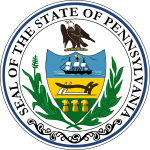| |||||||||||||||||||
All 13 Pennsylvania seats to the United States House of Representatives | |||||||||||||||||||
|---|---|---|---|---|---|---|---|---|---|---|---|---|---|---|---|---|---|---|---|
| |||||||||||||||||||
 Results: Results:Democratic-Republican Federalist | |||||||||||||||||||
Elections to the House of Representatives were held in Pennsylvania on October 14, 1794, for the Fourth Congress.
Background
Thirteen Representatives, 8 Anti-Administration (Democratic-Republican) and 5 Pro-Administration (Federalist), had been elected in the previous election on an at-large basis, the last time that Pennsylvania elected all of its representatives at-large. Ten incumbents (6 Anti-Administration and 4 Pro-Administration) ran for re-election.
Congressional districts
For the 1794 elections, Pennsylvania divided itself into 12 districts, one of which (the 4th) was a plural district, with 2 Representatives. These districts remained in use until redistricting after the census of 1800.
- The 1st district consisted of the City of Philadelphia
- The 2nd district consisted of Philadelphia County
- The 3rd district consisted of Chester and Delaware Counties
- The 4th district (2 seats) consisted of Montgomery, Bucks and Northampton Counties
- The 5th district consisted of Berks and Luzerne County
- The 6th district consisted of Northumberland and Dauphin Counties
- The 7th district consisted of Lancaster County
- The 8th district consisted of York County
- The 9th district consisted of Mifflin and Cumberland County
- The 10th district consisted of Bedford, Huntingdon and Franklin Counties
- The 11th district consisted of Westmoreland and Fayette Counties
- The 12th district consisted of Allegheny and Washington Counties
The counties that made up the 5th district did not border each other. That district was therefore made up of two separate pieces rather than being a single contiguous entity
Note: Many of these counties covered much larger areas in 1794 than they do today, having since been divided into numerous counties
Election returns
Ten incumbents (6 Democratic-Republicans and 4 Federalists) ran for re-election. The incumbents James Armstrong (F), from the 9th district, William Montgomery (DR) from the 11th district, and John Smilie (DR) from the 12th district did not run for re-election. Smilie would later return to the House in 1798, where he would remain until his death in 1812. Of the ten who ran for re-election, 6 (4 Democratic-Republicans and 2 Federalists) were re-elected. A total of 9 Democratic-Republicans and 4 Federalists were elected, a net gain of one seat for the Democratic-Republicans over the previous election.
Election results are unavailable from the 5th, 7th, 8th, and 11th districts, and are incomplete for the 9th.
| District | Democratic-Republican | Federalist | Other candidates | ||||||
|---|---|---|---|---|---|---|---|---|---|
| 1st | John Swanwick | 1,240 | 51.2% | Thomas Fitzsimons (I) | 1,182 | 48.8% | |||
| 2nd | Frederick Muhlenberg (I) | 656 | 56.3% | Samuel Miles | 510 | 43.7% | |||
| 3rd | Thomas Ross | 571 | 31.8% | Richard Thomas | 1,222 | 68.2% | |||
| 4th 2 seats |
James Morris | 1,648 | 20.2% | Samuel Sitgreaves | 2,594 | 36.2% | James Barclay (party unknown) | 195 | 2.4% |
| John Richards | 1,635 | 20.0% | |||||||
| Robert Lollar | 1,072 | 13.1% | |||||||
| Peter Muhlenberg (I) | 661 | 8.1% | |||||||
| 5th | Daniel Hiester (I) | ||||||||
| 6th | Samuel Maclay | 1,882 | 46.0% | John Carson | 438 | 10.7% | |||
| John A. Hanna | 1,722 | 43.3% | |||||||
| 7th | John W. Kittera (I) | ||||||||
| 8th | Thomas Hartley (I) | ||||||||
| 9th | Andrew Gregg (I) | James Wallace | |||||||
| William Irvine (I) | |||||||||
| 10th | David Bard | 1,808 | 52.9% | James Chambers | 519 | 15.2% | |||
| James McLane | 1,090 | 31.9% | |||||||
| 11th | William Findley (I) | ||||||||
| 12th | Albert Gallatin | 769 | 33.1% | Thomas Scott (I) | 643 | 27.7% | |||
| Daniel Hamilton | 377 | 16.2% | Isaac Tichenor | 256 | 11.0% | ||||
| Hugh H. Brackenridge | 140 | 6.0% | John Woods | 197 | 5.9% | ||||
In the 4th district, John Richards (DR) disputed the official returns (shown above) which showed himself in 3rd place and James Morris (DR) in 2nd. The Governor of Pennsylvania only issued certification for Samuel Sitgreaves (F). On July 10, 1795, before the House could act on the dispute, Morris died. The House voted Richards the legitimate winner of 2nd place, with the revised vote totals being 1,791 for Richards and 1,688 for Morris
Special elections
Daniel Hiester (DR), re-elected to the 5th district, resigned on July 1, 1796. A special election was held on October 11, 1796 (the same day as the 1796 general elections) to fill the resulting vacancy. Hiester would later be elected to Maryland's 4th congressional district in 1800
| District | Democratic-Republican | Federalist | ||||
|---|---|---|---|---|---|---|
| 5th | Joseph Hiester | 1,553 | 43.2% | George Ege | 2,039 | 56.8% |
Joseph Hiester was a cousin of Daniel.
See also
References
- Electoral data and information on districts are from the Wilkes University Elections Statistics Project
- District assignments based on residence information given in the 1792 returns
- ^ A dispute arose over whether James Morris or John Richards was in second place, see below for more details
